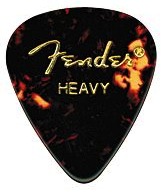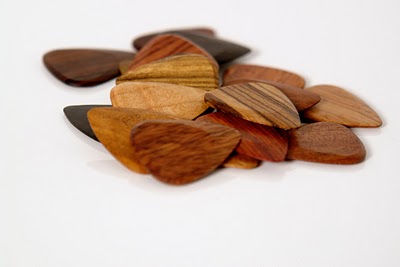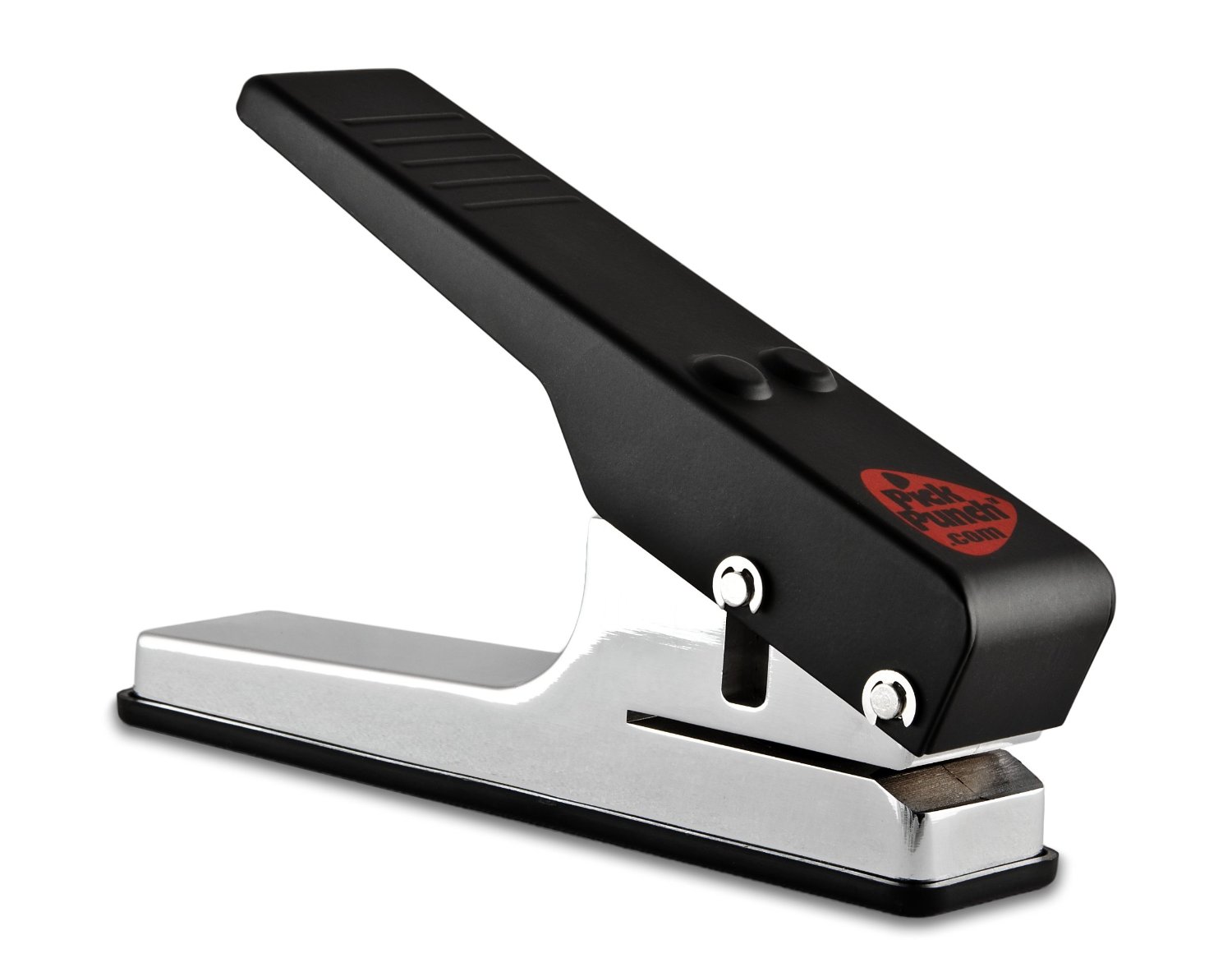Picking Your Plectrum: An Audio Comparison of Odd and Unusual Guitar Picks
This story first appeared in Trust Me, I’m a Scientist, November 3, 2013
Keys to the Kingdom
In an expectant moment before my first guitar lesson, I quickly grabbed a pick out of the tin at the front desk of my local music store.
I can’t be sure if it was a Fender, Dava, Peavey, whether it was heavy, medium, or light; but I do remember that my new pick felt like the passkey of the guitar world. That pick represented so much to me, and yet I rarely gave it much thought beyond mere necessity.
“Pick choice is brutally important to me,” guitarist Jared Blake Scharff of the SNL band told me recently. “So much so, that I slightly freak out if I don’t have my own picks.”
This is easy for most of us to understand. Many guitarists will end up settling on one type of pick in particular out of physical comfort. But recently, I’ve begun to wonder why we should settle for just one type when there’s a whole world of undiscovered opportunities for tone out there.
In this article, we’ll check out the most basic options – as well as some of the oddest – and hear first-hand how pick choice can change the tone, feel, and attack of a simple guitar part.
Fitting Pick to Music
My own revelation about pick choice came during a recording session for my recent solo guitar record, DiBenedetto. I was working with engineer Scott Solter, and looking to get a muted, “shush-y” sounding acoustic guitar part. Playing a particularly resonant dreadnought guitar, I tried out all manner of light and heavy standard picks.
Eventually, Scott handed me a small dremel bit, which I then taped on to the end of a regular pick, for ease of playing. The resulting tone was the exact sound we were going for: a brush-like tone with a kind of natural compression provided from the even pull of the dremel bit.
Scott’s obsession for getting the tone right at the source makes him consider these kind of subtleties right away: “It’s a commitment from the beginning and not a decision to put off for a later date,” he says. From that day on, I’ve always carried a box full of drastically different pick options to almost every recording session.
Plethora of Picks
Most well-stocked music stores have as many choices of picks as they do for guitars and pedals: Stone, ebony, wood, metal, felt, or rubber all provide new and interesting sounds.
Of course, some guitarists can’t imagine paying 5 dollars for a pick. A new pick could easily get lost, or it might feel uncomfortable and end up sitting in the bottom of a drawer somewhere for the rest of its life. But for the adventurous and the obsessed, the truth is that picks can have a profound effect on the sounds we get in our recordings. They can change the entire nature of a guitar track, and choosing the right one while tracking can save time spent futilely tweaking compression, EQ, and other effects later on. In my mind, that’s well worth the money.
In the audio examples below, we’ll explore what six different picks offer in terms of sound: A standard Fender Heavy Pick (our control), Wood, Stone, Ebony, Felt, and a Dremel tool. You’ll hear these examples on both acoustic and electric guitar. In most cases, the acoustic samples will provide even more transparent insight into the nature of the pick’s sound.
Fender Heavy
 The ubiquitous Fender tortoise shell pick draws its lineage from picks made out of actual tortoise shell. In recent decades, tortoise shell has become an illegal material in many countries, so the modern Fender Heavy is now made mostly from celluloid.
The ubiquitous Fender tortoise shell pick draws its lineage from picks made out of actual tortoise shell. In recent decades, tortoise shell has become an illegal material in many countries, so the modern Fender Heavy is now made mostly from celluloid.
Fender Heavys are easy to find, consistent from pick to pick, and give just enough “dig” for my tastes. This is always my go-to pick, and for this study it will act as our control.
Fender Heavy, Acoustic.
[audio:https://www.sonicscoop.com/wp-content/uploads/2016/11/1-01-01-Fender-Heavy-Pick-Acoustic.mp3%5D
Fender Heavy, Electric
Wood
Wood picks run the gamut from materials like oak, mahogany and maple, to coconut shell.
This particular pick is difficult to keep a handle on, but it provides some interesting tones that are practically impossible to coax out of most picks. I’m not 100% certain of the type of wood used for this particular pick, but it has a dark color and prominent grains, not unlike mahogany or rosewood.
On the acoustic, the tone it provides is certainly brighter, with a good amount of pick-attack sound added into the mix. But with that, we also get some amount of muting, which is not typical for a harder attack style pick.
On the electric guitar, the difference is minimal, with maybe a pinch of extra focus coming through on the attack of the note. This subtle accent, however, could settle EQ issues early on if used in the right setting.
With a more aggressive playing style, the clanky attack and tone of this pick sound could be highlighted even more. If used with a more sensitive touch, it can generate an even more muted tone with mostly attack coming through, and very little resonance.
Effect: Big jump between 2k-5kHz; Tiny bit of carving out around 180-200Hz
Wood Pick, Acoustic
[audio:https://www.sonicscoop.com/wp-content/uploads/2016/11/1-02-02-Wood-Pick-Acoustic.mp3%5D
Wood Pick, Electric
Stone
Every stone pick has a unique identity. and is as distinctive as the maker, type of stone, and some say, even time of day it was made.
Almost all the stone picks you’re likely to find will be quite thick, so that they won’t shatter, but most of them will be sufficiently smoothed out during the manufacturing process, making them a little bit easier to handle than you might think.
A big dose of brightness comes out in the acoustic guitar on this one, with almost every single stroke on every single string leaping out into the mix. Stone is so present in tone that even the angle at which the pick hits the string becomes important.
Once again, on the electric guitar samples, the tone is a little bit more focused than with a standard pick, and the attack comes out even more in the mix than with the wood. Still, the effect in this case is minimal, especially when compared with its effect on the acoustic guitar.
Very aggressive use of this pick and certain types of angling can heavily highlight string attack noise.
Effect: Lift at 2k and 5kHz
Stone Pick, Acoustic
[audio:https://www.sonicscoop.com/wp-content/uploads/2016/11/1-03-03-Stone-Pick-Acoustic.mp3%5D
Stone Pick, Electric
Ebony
While technically made out of wood, this pick is actually quite close to the stone one in terms of how it handles between the fingers. This particular Ebony pick has a slightly more focused sound than the control, but with a less accented pick attack than wood and stone. This is probably due to the beveling of this pick, and it’s wise to remember that this is just a singular example among so many other picks made from the same material.
On the acoustic, the pick attacks are more present, but in a smaller range and isolated to higher frequencies. This could be useful in a mix where a lot of space in the middle is already taken up, but you still want to get the attack of the pick to come through.
On the electric, the effect is again less noticeable, but the higher frequency tilt of the attack is still very much present when compared to a standard pick.
Effect: Carving out of frequencies between 400 – 500, significant jump in 4k-5k, a little bump from 8k-10k, with a general reduction between 200-400Hz
Ebony Pick, Acoustic
[audio:https://www.sonicscoop.com/wp-content/uploads/2016/11/1-04-04-Ebony-Pick-Acoustic.mp3%5D
Ebony Pick, Electric
Felt
Bass players have been hip to Felt picks for years. In fact, bass players (if they dare venture into pick territory at all) are usually much more well versed in all different kinds of pick materials than your average guitarist. Maybe it’s because bass players are asked so much to be in the background that Felt has become a favored pick.
On the acoustic guitar, the most noticeable effect is a drop in volume. Beyond that, there’s a significant amount of muting that occurs, and we get an accentuated “puh” sound from the guitar.
On the electric, we get the effect of having almost no attack – as if the attack on each note is delayed by a few milliseconds.
Using this pick very softly and close to the neck on an acoustic guitar will provide an even more pronounced muting and “in the background” tonality- a difficult effect to achieve with EQ or other audio engineering tricks.
Effect: Reduction in frequencies above 450Hz – with a tiny lift around 550Hz and 1kHz
Felt Pick, Acoustic
[audio:https://www.sonicscoop.com/wp-content/uploads/2016/11/1-05-05-Felt-Pick-Acoustic.mp3%5D
Felt Pick, Electric
Dremel Brush
This is the pick that I discovered when engineer Scott Solter threw one at me and asked me to play with it. The effect was magnificent.
In our acoustic example here, we get a nice mixture of the kind of muting we heard with the felt pick, along with a sort of “fanning” of the strings. I’ve taped a regular pick to the top of it to make it easier to play with.
On the electric guitar samples and on single note lines, the effect is less pronounced, but there’s still a faint “tuh” sound going on with some of the notes here, which you can make more significant by digging in even harder.
Effect: Significant reduction in frequencies above 500 Hz
Dremel Brush, Acoustic
[audio:https://www.sonicscoop.com/wp-content/uploads/2016/11/1-06-06-Dremel-Brush-Acoustic.mp3%5D
Dremel Brush, Electric
Your picks
These options are only the tip of the iceberg. I’ve used paper as a pick in the past, while guitarists like Oscar Albis Rodriguez of the indie rock group A Great Big World suggest using a drumstick on guitar: “You can use the drumstick to play chords so that all the strings are attacked simultaneously, like how the hammers of a piano strike their strings,” he says.
Ultimately, almost anything can be used as a plectrum, and with the advent of tools like a pick puncher, you can make your own strange pick creations at home.
Sure, all those things we as guitarists think are so important – pedals, guitars, amps, cables, gain staging – still are. But perhaps more than anything, your tone comes from your hands. Maybe it’s time to think about what you’re holding. Sometimes a little change in pick choice can point your sound in exactly the direction it needs to go.
Rich Bennett is a guitarist and composer living in Brooklyn.
Please note: When you buy products through links on this page, we may earn an affiliate commission.










